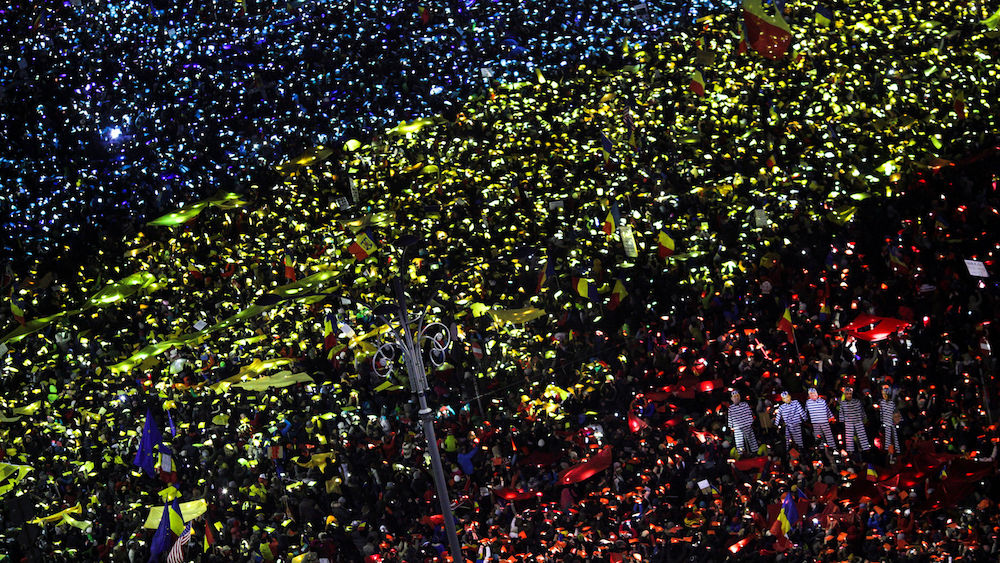A controversial decree passed by the government has spurred hundreds of thousand of Romanians to the streets. Can the protesters bring real reform to Romania’s corrupt government?
Romanians are upset, to put it mildly. Over the last two weeks, hundreds of thousands of them have gathered in dozens of cities across the country to protest against government attempts to weaken anti-corruption laws. The demonstrators have chanted, danced, debated, waved signs, and sung the national anthem. And for more than 13 days in a row, they have occupied – and still continue to occupy – Victory Square in central Bucharest, opposite the seat of government.
They were spurred to action after the Social Democratic (PSD)-led government passed a controversial emergency decree to decriminalize official misconduct, where the financial damage was less than 200,000 Romanian Lei (approximately €44,000). The aim was clear: the law would legalize petty bribery.
It was a short-lived decree. The PSD couldn’t ignore the escalating number of protesters – who reached an estimated 200,000 in Bucharest on February 5 – and the international attention. The government bowed to the pressure, issuing a new decree that essentially revoked the original one. The official architect of the initial law, Minister of Justice Florin Iordache, then resigned.
But the public, riding the swell of discontent, wants more. Despite temperatures that dropped to minus seven degrees Celsius last Sunday, tens of thousands gathered once more in front of the government to chant “Thieves!” and “Resign!” In a stunning display of glittering lights beamed around the world, the protesters formed a giant Romanian flag by raising pieces of colored paper in blue, yellow, and red. They want nothing less than the entire government to stand down.
Romanians want to ensure what happened on January 31 can’t happen again. They don’t trust a government that passes laws in the dark of the night with no public debate, especially not when that legislation benefits many members of their own political party who have either been indicted or are on trial for corruption. The current government was elected in December 2016, and the governing party – the PSD – has historically been associated with corrupt practices.
The demonstrations are the largest since the fall of communism in 1989, but the wave of public dissent actually began back in 2012. Protest movements were first triggered by a health reform; public frustration then spilled over into demonstrations against the political elite. In 2013, protests erupted again when the government gave the green light to a gold mine in the Apuseni Mountains of Transylvania, where ancient Roman galleries still remain. These protests, which attracted over 30,000 on one night alone, helped shaped a newfound sense of cultural identity and empowered a civic consciousness. They were also effective: work never began on the mine.
Then there was the tragic nightclub fire in Colectiv in Bucharest that saw 64 people die after an indoor fireworks display ignited the ceiling and walls. Tens of thousands demonstrated, blaming graft for poor safety regulations. This public display of anger forced the then government led by Prime Minister Victor Ponta to resign, ushering in the technocratic leadership. Ponta was already on trial for fraud, money laundering, and tax evasion at that point. The surge of demonstrations cemented the belief among Romanians that their protests could indeed effect change.
Rooting out Corruption
Corruption is not a new phenomenon in Romania – it has always been a serious issue, but the fight against graft has intensified since the country joined the European Union in 2007. Institutions like the National Anti-Corruption Directorate (DNA) started to score major successes by putting several former ministers and top officials behind bars. Adrian Nastase, former prime minister of Romania, along with ministers and members of parliament, were put on trial.
The DNA, led by 43 year-old prosecutor Laura Codruta Kovesi, was launched back in 2002, but it only began to carry out investigations into high level corruption in earnest in 2006. These days, the agency enjoys high confidence among Romanians. Several surveys conducted in recent years put the DNA among the most trusted institutions in Romania, higher even than the Orthodox Church. The PSD has the largest number of indicted members; it’s not a surprise that the party claims the DNA’s investigations are politically motivated.
Despite the DNA’s recent progress, corruption is rooted deep in Romanian mentality. It starts in infant years and ends on the hospital bed; Romanians have to bribe everyone from teachers in school to employees in public institutions and doctors in order to survive. So when the New York Times asked Romanians to share their own experiences of corruption, the answers were quite predictable.
Graft is so chronic that the idea of mayors winning elections from behind bars has become commonplace. In Baia Mare, a city in northwestern Romania, 38-year-old Catalin Chereches won the local elections in 2016 with some 70 percent of the vote to secure his second mandate – even though he was arrested for taking a bribe in his first term.
On the streets of Baia Mare, most residents admitted that they were willing to overlook his legal issues. “Chereches did a lot for our town,” they said. “He repaired streets, built parks and playgrounds for children. So what if he stole a little?”







